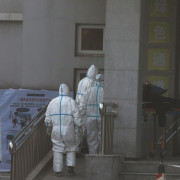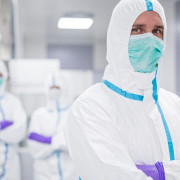Racial data transparency
Содержание:
- Preparing for a Spike or Second Wave of Coronavirus in Your Area
- Tracking Coronavirus Surges
- Children with Medical Conditions
- Latest News & Resources
- How long will protection last following vaccination?
- Should children get the vaccine?
- What is herd immunity from the coronavirus?
- About this page:
- Latest News & Resources
- What causes a spike in coronavirus cases?
- Главные мифы coronavirus
- When will a vaccine be available?
- Cases, Deaths, and Testing in All 50 States
Doctors, clinics and hospitals recognize that more COVID-19 surges are likely to occur. They are working with manufacturers to stock up on equipment, and they are continuing their policies for protecting patients and staff members.
Here’s what you can do now:
- Continue to practice COVID-19 precautions, such as physical distancing, hand-washing and mask-wearing.
- Stay in touch with local health authorities, who can provide information if COVID-19 cases begin to increase in your city or town.
- Make sure your household maintains two weeks’ worth of food, prescription medicines and supplies.
- Work with your doctor to ensure that everyone in your household, especially children, is up to date on vaccines, including this year’s flu shot.
There is a delay between a policy change such as reopening businesses or relaxing occupancy limits in a community and when the effects of this change show up in the COVID-19 data. An increase in the number of COVID-19 cases or hospitalizations will not be seen a week or even two weeks later. It seems to take much longer, perhaps as many as six to eight weeks, for effects of a policy or widespread behavior change to appear in the population-level data.
When a person is exposed to the coronavirus, it can take up to two weeks before they become sick enough to go to the doctor, get tested and have their case counted in the data. It takes even more time for additional people to become ill after being exposed to that person, and so on. Several cycles of infection must occur before a noticeable increase shows in the data that public health officials use to track the pandemic.
Children with Medical Conditions
Asthma: Children with asthma may have more severe symptoms from COVID-19 or any other respiratory disease, including the flu. There are no indications that most children with asthma experience severe symptoms due to the coronavirus, but observe them carefully and, if symptoms develop, call the child’s doctor to discuss next steps and to arrange appropriate evaluation as needed. Keep your child’s medications refilled and take extra care to avoid things that set off asthma attacks in your child.
Diabetes: Control of blood sugar is key. Children with well-managed diabetes are not expected to be more susceptible to COVID-19. But poorly controlled diabetes can weaken the immune system, so parents and doctors should watch these children carefully for signs and symptoms that may require evaluation.
Latest News & Resources
c http-equiv=»Content-Type» content=»text/html;charset=UTF-8″>lass=»NewsFeed_controls__1de3n»>
New
Vaccines are finally starting to roll out, but the virus is spreading faster than ever — and killing thousands of Americans daily.
The Moderna coronavirus vaccine was recommended for emergency authorization by an FDA panel, following the FDA approval of the Pfizer vaccine last week
Friday December 18, 2020 12:00-1:00 ET
As the pandemic surges to dangerous, record-breaking levels, we are launching the first in a series of bi-weekly webcast briefings on the CRC this coming Friday at noon. The series will provide timely, accessible updates on the state of the pandemic and public health responses, and will offer opportunities for live Q&A with leading experts from the Johns Hopkins Coronavirus Resource Center.
The U.S. death toll from the coronavirus topped 300,000 Monday just as the country began dispensing COVID-19 shots in a monumental campaign to conquer the pandemic.
Health care workers around the country rolled up their sleeves for the first COVID-19 shots Monday as hope that an all-out vaccination effort can defeat the coronavirus smacked up against the heartbreaking reality of 300,000 U.S. deaths.
As coronavirus deaths soar across the country, deaths in communities that are home to colleges have risen faster than the rest of the nation.
Over the next six months, the U.S. hopes to distribute enough doses of the coronavirus vaccine to reach the arm of every American.
Friday December 11, 2020 12:00-12:30 ET
As the pandemic surges to dangerous, record-breaking levels, we are launching the first in a series of bi-weekly webcast briefings on the CRC this coming Friday at noon. The series will provide timely, accessible updates on the state of the pandemic and public health responses, and will offer opportunities for live Q&A with leading experts from the Johns Hopkins Coronavirus Resource Center.
Reducing the spread of COVID-19 over the next several months — while vaccines are being distributed — has the potential to save more than 100,000 American lives.
Pfizer’s COVID-19 vaccine candidate offers some protection after the first dose, with nearly full protection after the second dose.
Dr. William Moss, executive director of the International Vaccine Access Center at Johns Hopkins University, encouraged anyone who has already tested positive for COVID-19 to get vaccinated once a vaccine becomes available.
With the arrival of December, it’s now clear the winter surge of the pandemic is materializing in many of the ways that the country’s top scientists and health care leaders feared.
Friday December 4, 2020 12:00-12:30 ET
As the pandemic surges to dangerous, record-breaking levels, we are launching the first in a series of bi-weekly webcast briefings on the CRC this coming Friday at noon. The series will provide timely, accessible updates on the state of the pandemic and public health responses, and will offer opportunities for live Q&A with leading experts from the Johns Hopkins Coronavirus Resource Center.
Though the agency has issued all of the recommendations in earlier guidance, the new summary represents the first time the C.D.C. published a multi-pronged list of strategies for states, a sort of battle plan.
Experts emphasize the importance of transparent messaging in ensuring wide public acceptance and completion of vaccination regimens.
How long will protection last following vaccination?
We do not know how long protection will last following vaccination but it will be critically important to measure long-term protection (at least two years) in the phase 3 trials and in other groups prioritized for early vaccination. We are still learning about the duration of protection following infection with SARS-CoV-2 and it is too early to tell how long protection will last. There have already been cases where individuals have been shown to be infected twice but most often the second illness was mild or without any symptoms. This is what we would expect with an immune response that protects against disease but not infection.
There are ways to potentially make protection following vaccination more durable than following natural infection, such as with an adjuvant, an ingredient used in some vaccines that helps create a stronger immune response, or with booster doses of vaccine. These strategies to enhance vaccines may be particularly important for vulnerable populations, such as the elderly and those with underlying diseases, who are at particular risk of severe Covid-19 but are also less likely to develop a protective immune response to a vaccine.
Should children get the vaccine?
Children will not be a priority group for a vaccine early in vaccine deployment but will likely be eligible as vaccine availability improves. The major vaccine clinical trials are currently focused on enrolling adults, and as they expand, the inclusion of children in vaccine clinical trials will produce data on safety and efficacy that can be applied to children. While children are less likely to develop severe disease and die from Covid-19, there are several reasons for ensuring that eventually there is a vaccine that is safe for children. Although rare, some children may develop severe disease or die from Covid-19. Children have also developed a severe inflammatory syndrome, called multisystem inflammatory syndrome in children. Children may be important transmitters of SARS-CoV-2 and vaccinating them with a vaccine that reduces transmission could be important in controlling the pandemic. Finally, having a safe vaccine for children will build confidence towards opening up schools and learning centers for in-person educational processes.
Herd immunity is a public health term that refers to the fact that, when enough people in a community have immunity from a disease, the community is protected from outbreaks of that disease.
Infectious disease experts at The Johns Hopkins University explain that about 70% of the population needs to be immune to this coronavirus before herd immunity can work. People might be immune from the coronavirus, at least for a while, if they have already had it, but we don’t know this yet. A widely available, safe and effective vaccine may not be available for months.
Without a vaccine, most doctors and scientists agree that a herd immunity approach of letting the virus “take its course” is not acceptable. Letting the coronavirus circulate freely among the public would result in hundreds of thousands of deaths and millions more people left with lasting lung, heart, brain or kidney damage.
About this page:
This page was last updated on Wednesday, December 23, 2020 at 03:00 AM EST.
These charts lay out the key metrics for understanding the reach and severity of COVID-19 in a given area: number of new daily cases, tests per 100,000 people (testing rate), and percentage of tests that are positive (positivity rate).
Positivity rates are a measure of testing capacity, and can help gauge whether governments are casting a wide enough net with their testing programs to identify infections that may be occurring. While this metric can provide important context about case totals and trends, it is NOT a measure of how prevalent the virus is in communities. Policy decisions, like openings and closings or interstate travel, should not be determined based on test positivity alone. Considering confirmed new cases, testing rates, and percent positivity together gives us a fuller picture of COVID-19 in a particular state or region.
More Details
arrow-rightCreated with Sketch.
7-Day Averages: The CRC calculates the rolling 7-day average separately for daily cases and daily tests, and then for each day calculate the percentage over the rolling averages. Some states may be calculating the positivity percentage for each day, and then doing the rolling 7-day average. The reason why we use our approach is because testing capacity issues and uneven reporting cadences create a lot of misleading peaks and valleys in the data. Since we want to give a 7-day average, it is more fair to average the raw data and then calculate the ratios. Otherwise, days when a large number of negative tests are released all at once—and positivity is going to be very low—will have the same weight as days when data was steadily released, and the overall result is going to be lower. Our approach is applied to all our testing data to correct for these uneven data release patterns.
Positivity rates can tell us whether a state’s testing capacity is sufficient. Ideally, a state should be meeting or exceeding the recommended positivity rate, which the WHO has set at 5%. A positivity rate over 5% indicates a state may only be testing the sickest patients who seek out medical care, and are not casting a wide enough net to identify milder cases and track outbreaks.
Percent positivity can also help us determine if an increase in cases is simply the result of expanded testing or if it signals increased transmission of the virus. If we see the percentage of positive tests begin to rise, it indicates insufficient testing to find infections that may be occurring. Not finding these infections may mean that the virus is transmitting without intervention, which can lead to future case growth.
Specifically:
-
If a rise in cases is the result of increased testing, the percent positive line could look flat or like it is decreasing over the time period when cases increased.
-
If a rise in cases is the result of increased transmission, the line could appear to be increasing over that same time period.
How we calculate positivity
arrow-rightCreated with Sketch.
7-Day Averages: The CRC calculates the rolling 7-day average separately for daily cases and daily tests, and then for each day calculate the percentage over the rolling averages. Some states may be calculating the positivity percentage for each day, and then doing the rolling 7-day average. The reason why we use our approach is because testing capacity issues and uneven reporting cadences create a lot of misleading peaks and valleys in the data. Since we want to give a 7-day average, it is more fair to average the raw data and then calculate the ratios. Otherwise, days when a large number of negative tests are released all at once—and positivity is going to be very low—will have the same weight as days when data was steadily released, and the overall result is going to be lower. Our approach is applied to all our testing data to correct for these uneven data release patterns.
Latest News & Resources
c http-equiv=»Content-Type» content=»text/html;charset=UTF-8″>lass=»NewsFeed_controls__1de3n»>
New
Vaccines are finally starting to roll out, but the virus is spreading faster than ever — and killing thousands of Americans daily.
The Moderna coronavirus vaccine was recommended for emergency authorization by an FDA panel, following the FDA approval of the Pfizer vaccine last week
Friday December 18, 2020 12:00-1:00 ET
As the pandemic surges to dangerous, record-breaking levels, we are launching the first in a series of bi-weekly webcast briefings on the CRC this coming Friday at noon. The series will provide timely, accessible updates on the state of the pandemic and public health responses, and will offer opportunities for live Q&A with leading experts from the Johns Hopkins Coronavirus Resource Center.
The U.S. death toll from the coronavirus topped 300,000 Monday just as the country began dispensing COVID-19 shots in a monumental campaign to conquer the pandemic.
Health care workers around the country rolled up their sleeves for the first COVID-19 shots Monday as hope that an all-out vaccination effort can defeat the coronavirus smacked up against the heartbreaking reality of 300,000 U.S. deaths.
As coronavirus deaths soar across the country, deaths in communities that are home to colleges have risen faster than the rest of the nation.
Over the next six months, the U.S. hopes to distribute enough doses of the coronavirus vaccine to reach the arm of every American.
Friday December 11, 2020 12:00-12:30 ET
As the pandemic surges to dangerous, record-breaking levels, we are launching the first in a series of bi-weekly webcast briefings on the CRC this coming Friday at noon. The series will provide timely, accessible updates on the state of the pandemic and public health responses, and will offer opportunities for live Q&A with leading experts from the Johns Hopkins Coronavirus Resource Center.
Reducing the spread of COVID-19 over the next several months — while vaccines are being distributed — has the potential to save more than 100,000 American lives.
Pfizer’s COVID-19 vaccine candidate offers some protection after the first dose, with nearly full protection after the second dose.
Dr. William Moss, executive director of the International Vaccine Access Center at Johns Hopkins University, encouraged anyone who has already tested positive for COVID-19 to get vaccinated once a vaccine becomes available.
With the arrival of December, it’s now clear the winter surge of the pandemic is materializing in many of the ways that the country’s top scientists and health care leaders feared.
Friday December 4, 2020 12:00-12:30 ET
As the pandemic surges to dangerous, record-breaking levels, we are launching the first in a series of bi-weekly webcast briefings on the CRC this coming Friday at noon. The series will provide timely, accessible updates on the state of the pandemic and public health responses, and will offer opportunities for live Q&A with leading experts from the Johns Hopkins Coronavirus Resource Center.
Though the agency has issued all of the recommendations in earlier guidance, the new summary represents the first time the C.D.C. published a multi-pronged list of strategies for states, a sort of battle plan.
Experts emphasize the importance of transparent messaging in ensuring wide public acceptance and completion of vaccination regimens.
Human behavior is the major factor. State and local governments, as well as individual people, differ in their response to the pandemic. Some follow COVID-19 precautions, such as physical distancing, hand-washing and mask-wearing. Others are not as prescriptive in requiring these measures or in restricting certain high risk activities.
In some cities, towns and communities, public places are closed or practicing limitations (such as how many people are allowed inside at one time); others are operating normally. Some government and community leaders encourage or even mandate mask wearing and physical distancing in public areas. Others say it is a matter of personal choice.
However, the relationship between those precautions and cases of COVID-19 is clear: In areas where fewer people are wearing masks and more are gathering indoors to eat, drink, observe religious practices, celebrate and socialize, even with family, cases are on the rise.
Also, places where people live or work closely together (multigenerational households, long term care facilities, prisons and some types of businesses) have also tended to see more spread of the coronavirus. Coronavirus outbreaks at nursing homes and “superspreader” events — gatherings of people where one infected person or more transmits the virus to many others — continue to occur.
When will a vaccine be available?
Vaccines for SARS-CoV-2 will be available when they are demonstrated to be safe and efficacious in large phase 3 clinical trials, have been approved by regulatory authorities (the Food and Drug Administration in the United States), and have been manufactured and distributed to places where people can be vaccinated.
To demonstrate efficacy, sufficient differences in disease must be observed between those who received the viral vaccine and those who received the placebo or comparison vaccine in a phase 3 clinical trial. This depends on the likelihood of infection in places where the studies are conducted but can take from several months to years. Once sufficient data are available to be confident that the vaccine is efficacious, and no evidence of serious adverse events is identified, a rigorous and transparent approval process should take place.
Manufacturing capacity has already been developed for some vaccines and vaccine distribution systems are being put in place. However, because of limited quantities of vaccine, some groups of people will be offered the vaccine first, likely health care workers, other essential personnel, and those most vulnerable to severe disease and death.
Cases, Deaths, and Testing in All 50 States
U.S.: Are We Testing Enough?
This graph shows the total number of cases, deaths, and tests performed in each state per 100,000 people. By comparing the rate of cases and deaths, we can get a sense of how COVID-19 has affected each state. Since confirmed case numbers may be dependent on how much testing a state is doing, it is also important to see how many tests have occurred in each state. If people who are infected cannot get tested, they will not be counted as a confirmed case in the state’s data.
Data Sources:
Testing data from The COVID Tracking Project;
cases data from JHU CSSE;
and population from ACS 1-year data (2018).;
It is important to track the testing that states are doing to diagnose people with COVID-19 infection in order to gauge the spread of COVID-19 in the U.S. and to know whether enough testing is occurring. When states report the number of COVID-19 tests performed, this should include the number of viral tests performed and the number of patients for which these tests were performed. Currently, states may not be distinguishing overall tests administered from the number of individuals who have been tested. This is an important limitation to the data that is available to track testing in the U.S., and states should work to address it.
When states report testing numbers for COVID-19 infection, they should not include serology or antibody tests. Antibody tests are not used to diagnose active COVID-19 infection and they do not provide insights into the number of cases of COVID-19 diagnosed or whether viral testing is sufficient to find infections that are occurring within each state. States that include serology tests within their overall COVID-19 testing numbers are misrepresenting their testing capacity and the extent to which they are working to identify COVID-19 infections within their communities. States that wish to track the number of serology tests being performed should report those numbers separately from viral tests performed to diagnose COVID-19.
Our data provider, The Covid Tracking Project, is in the process of changing how it maps states’ data to the categories we use for our positivity calculations. These changes mean the category of data we use in our denominator (Total tests) may now include tests previously not included in our calculations, which in turn may result in a test positivity calculation that is lower than what we would have calculated for the state prior to the change.
With this significant change, we will once again review our data inputs and calculations to ensure that our numbers reflect the most responsible public health calculation of test positivity.






